万字详解Linux系列基础IO
Posted 山舟
tags:
篇首语:本文由小常识网(cha138.com)小编为大家整理,主要介绍了万字详解Linux系列基础IO相关的知识,希望对你有一定的参考价值。
文章目录
前言
有关C语言中对文件的操作可以在C语言文件操作中查看。
(1)当前目录
先来看一段代码:
#include <stdio.h>
int main()
//如果文件不存在,默认在当前目录下创建文件
FILE* fp = fopen("log.txt", "w");
if (fp == NULL)
perror("fopen");
return 1;
fprintf(fp, "hello world!");
fclose(fp);
return 0;
运行结果如下:
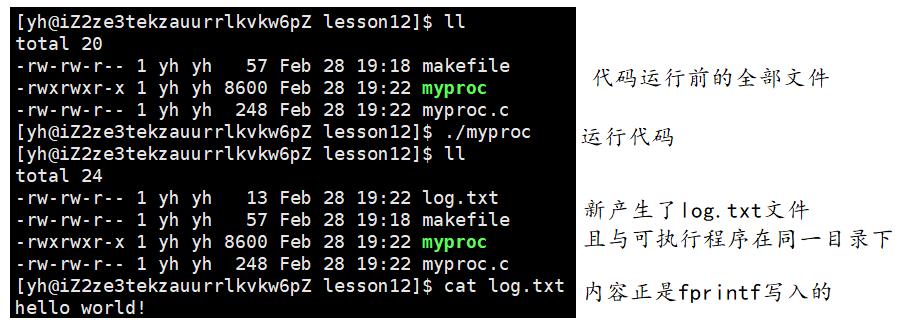
从上可以看出创建的文件与可执行程序在同一目录下,这一理解其实不对,请看下面的例子。
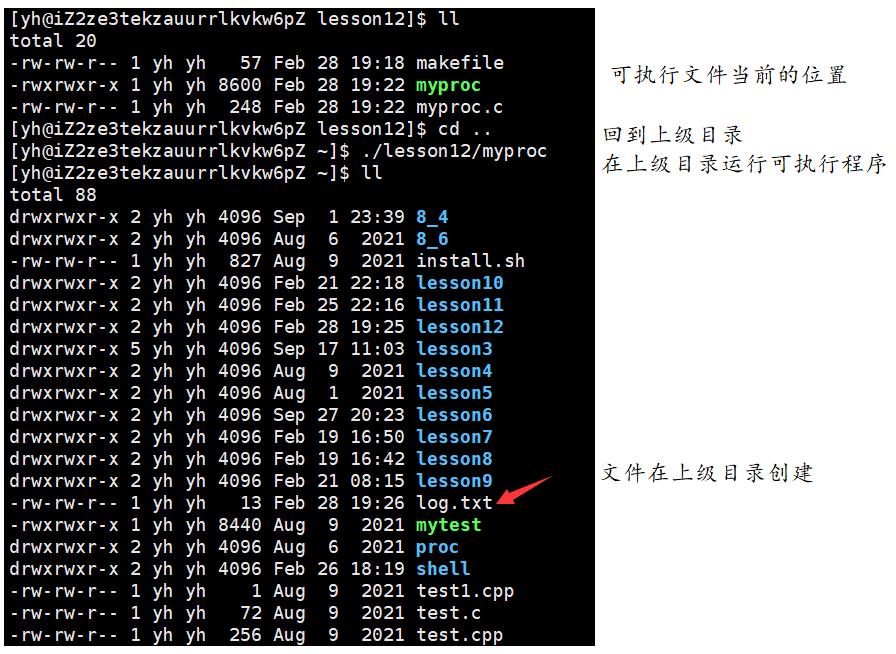
所以当前目录是进程运行时所处的目录,具体可通过下面的方式来查看。
#include <stdio.h>
#include <unistd.h>
int main()
//如果文件不存在,默认在当前目录下创建文件
FILE* fp = fopen("log.txt", "w");
if (fp == NULL)
perror("fopen");
return 1;
fprintf(fp, "hello world!");
fclose(fp);
while(1)//进程死循环,便于查看进程信息
sleep(1);
return 0;

(2)stdin、stdout、stderr
C语言任何进程默认会打开三个输入输出流,分别是stdin、stdout、stderr(分别对应键盘、显示器、显示器),事实上这三个流的类型都是FILE*,它们本质上都是文件指针。

因为它们都是默认打开的,所以C语言中scanf可以直接从键盘读、printf可以直接向显示器输出。
//下面的写法两两等价
char buffer[1024];
fgets(buffer, 1000, stdin);//从stdin(键盘)读其实等价于scanf
scanf("%s", buffer);
fprintf(stdout, "hello world!");//向stdout(显示器)输出其实等价于printf
fprintf(stderr, "hello world!");//stderr也是显示器,所以这样也可以向显示器输出
printf("hello world!");
一、open
用open来引出系统级别的IO。
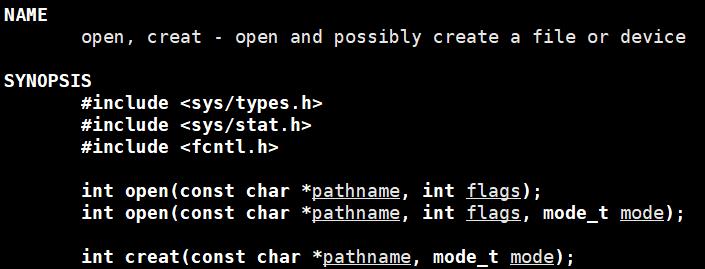
(上图只是man中对open最直接的介绍,各种参数及用法并没有放在图中)
pathname是要打开或创建的目标文件。
参数flags有很多,比如O_RDONLY(只读打开)、O_WRONLY(只写打开)、O_RDWR(读,写打开)这三个常量,必须指定一个且只能指定一个;还有O_CREAT(若文件不存在,则创建,且需要使用mode选项,来指明新文件的访问权限)、O_APPEND(追加写)。
返回值:成功则返回新打开的文件的文件描述符(后面会提到),失败则返回-1。
(1) 标志位
flags是一个int类型的参数,而int有32个比特位,把每一位为1都定义为一个宏,在这种规则下就可以定义出32种状态,当需要同时满足多种状态时只需要“或”操作即可。
比如将0x1定义为O_WRONLY、0x20定义为O_CREAT,则它们的二进制序列如下:
00000000 00000000 00000000 00000001 O_WRONLY
00000000 00000000 00000010 00000000 O_CREAT
传入参数后,只需检测flags哪一个比特位为1就可以识别出传入了哪种状态;如果需要同时传入多种状态,只需取“或”运算。
这样只用一个int型的参数就能定义出很多的状态(包括各自的组合)。
(2) O_WRONLY
#include <stdio.h>
#include <sys/types.h>
#include <sys/stat.h>
#include <fcntl.h>
int main()
int fd = open("log.txt", O_WRONLY);
printf("fd : %d\\n", fd);
return 0;

可以看到返回值为-1,说明有错误,且当前目录下并没有log.txt,原因是系统级别的open不同于C语言中的fopen,它在只写且文件不存在时不会自动创建。
(3) O_CREAT
#include <stdio.h>
#include <sys/types.h>
#include <sys/stat.h>
#include <fcntl.h>
int main()
// 加入O_CREAT,在文件不存在时自动创建
int fd = open("log.txt", O_WRONLY | O_CREAT);
printf("fd : %d\\n", fd);
return 0;

加入O_CREAT后,fd返回值不是-1说明open正常返回,当前目录下也创建出了log.txt,但很明显看到新创建的文件的权限是乱的,log.txt本身也自动用红底标注出来。
#include <stdio.h>
#include <sys/types.h>
#include <sys/stat.h>
#include <fcntl.h>
int main()
umask(0);//将掩码设置为0
int fd = open("log.txt", O_WRONLY, 0666);//将log.txt的权限设置为0666,注意第一个0不能省略
printf("fd : %d\\n", fd);
return 0;
这样一个具有特定权限的log.txt就创建出来了。(有关掩码、权限等可在【万字详解Linux系列】权限管理中查看)

二、close,read,write

像C语言中fclose与fopen对应一样,系统层面的close也和open相对应。
//count是希望读入或写入的个数
//返回实际读入或写入的个数
ssize_t write(int fd, const void *buf, size_t count);
ssize_t read(int fd, void *buf, size_t count);
下面代码用系统接口write向文件中写入内容。
#include <stdio.h>
#include <sys/types.h>
#include <sys/stat.h>
#include <unistd.h>
#include <fcntl.h>
#include <string.h>
int main()
umask(0);
int fd1 = open("log.txt", O_WRONLY, 0666);
if (fd1 < 0)
printf("open error!\\n");
return 1;
int count = 5;
const char* msg = "hello world!\\n";
while (count--)
//注意最后的参数如果用strlen(msg)+1把'\\0'算上是不对的
//因为字符串以'\\0'结尾是C语言的规定
//向文件里写入时不需要管'\\0'
write(fd1, msg, strlen(msg));
close(fd1);
return 0;
成功创建log.txt并向其中写入了5个hello world!
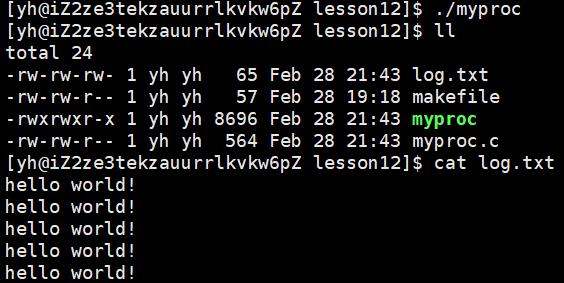
下面再使用read读取文件内的内容。
#include <stdio.h>
#include <sys/types.h>
#include <sys/stat.h>
#include <unistd.h>
#include <fcntl.h>
#include <string.h>
int main()
umask(0);
int fd1 = open("log.txt", O_RDONLY, 0666);//以只读的方式打开
if (fd1 < 0)
printf("open error!\\n");
return 1;
char c;
while (1)
//每次向c内读一个字符,num返回读到的字符个数
ssize_t num = read(fd1, &c, 1);
if (num <= 0)//如果没有读到字符就退出
break;
write(stdout, &c, 1);//向屏幕输出
close(fd1);
return 0;
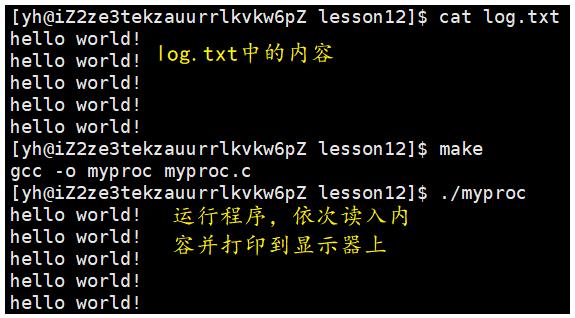
fopen、fclose、fread、fwrite等都是C标准库(libc)当中的函数,称之为库函数,通过libc这一层封装,在保证可读性的同时也兼顾了跨平台性。而open、close、read、write等等都属于系统提供的接口,是系统调用接口。
三、文件描述符
1.概念
上面open返回的值要么是-1(失败),要么是3,它会是其他值吗?
下面连续创建5个文件,查看每个open的返回值有什么规律。
#include <stdio.h>
#include <sys/types.h>
#include <sys/stat.h>
#include <fcntl.h>
int main()
umask(0);
int fd1 = open("log.txt", O_WRONLY | O_CREAT, 0666);
printf("fd1 : %d\\n", fd1);
int fd2 = open("log.txt", O_WRONLY | O_CREAT, 0666);
printf("fd2 : %d\\n", fd2);
int fd3 = open("log.txt", O_WRONLY | O_CREAT, 0666);
printf("fd3 : %d\\n", fd3);
int fd4 = open("log.txt", O_WRONLY | O_CREAT, 0666);
printf("fd4 : %d\\n", fd4);
int fd5 = open("log.txt", O_WRONLY | O_CREAT, 0666);
printf("fd5 : %d\\n", fd5);
close(fd1);
close(fd2);
close(fd3);
close(fd4);
close(fd5);
return 0;
很明显看到5个返回值是从3开始递增的。

-1表示失败,所以中间少了0、1、2三个文件描述符。还记得前言中提到的stdin、stdout、stderr吗?没错,这三个文件对应的文件描述符依次是0、1、2。因为它们是默认已经打开的,所以再创建时文件描述符从3开始依次递增(事实上,文件描述符的本质是数组下标)。
由于1、2代表的特殊意义,前面的代码可以如下修改。
#include <stdio.h>
#include <sys/types.h>
#include <sys/stat.h>
#include <unistd.h>
#include <fcntl.h>
#include <string.h>
int main()
umask(0);
int fd1 = open("log.txt", O_RDONLY, 0666);//以只读的方式打开
if (fd1 < 0)
printf("open error!\\n");
return 1;
char c;
while (1)
//每次向c内读一个字符,num返回读到的字符个数
ssize_t num = read(fd1, &c, 1);
if (num <= 0)//如果没有读到字符就退出
break;
//下面三种写法等价
write(stdout, &c, 1);
write(1, &c, 1);//1是显示器的文件描述符,即向屏幕输出
write(2, &c, 1);//2也显示器的文件描述符,即向屏幕输出
close(fd1);
return 0;
如果关闭0、1、2中的一个或几个会发生什么呢?请看下面的代码。
#include <stdio.h>
#include <sys/types.h>
#include <sys/stat.h>
#include <unistd.h>
#include <fcntl.h>
#include <string.h>
int main()
close(1);//关闭1文件描述符,也即关闭显示器
printf("hello world!\\n");
return 0;
运行后并没有打印hello world!,因为printf底层就是向显示器(文件描述符为1)中打印内容,但它被关闭了,所以自然无法打印出内容来。同理,如果把文件描述符0关掉,就无法从键盘输入。

2.原理
因为每个进程都可以打开多个文件,而系统中时刻都存在大量运行中的进程,所以也就存在大量的已经打开的文件,而每个文件有包括它的内容和属性,所以文件管理就是操作系统必须做的。Linux中用struct file这个结构体就是来管理文件。
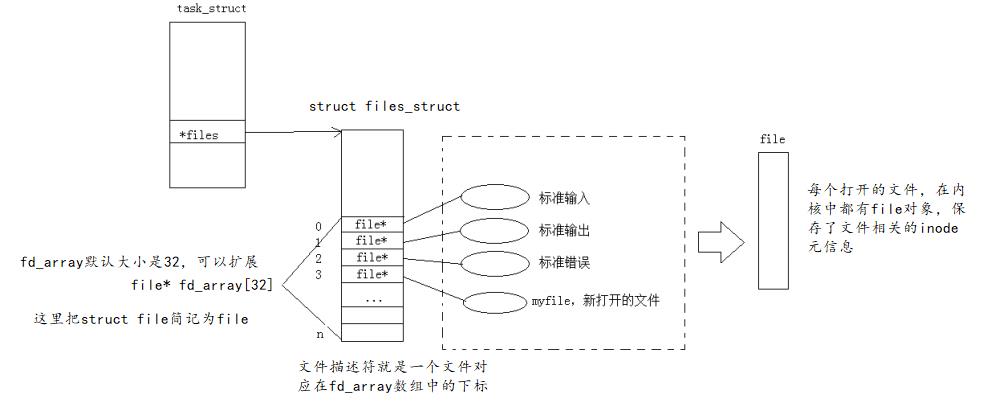
文件描述符就是从0开始的整数。当打开文件时,操作系统在内存中要创建相应的数据结构来描述目标文件,于是就有了file结构体表示一个已经打开的文件对象。而进程执行IO系统调用必须让进程和文件关联起来。每个进程都有一个指针*files, 指向一张表files_struct,该表包含一个指针数组,每个元素都是一个指向打开文件的指针。所以,本质上,文件描述符就是该数组的下标。所以,只要拿着文件描述符,就可以找到对应的文件。
3.分配规则
再看下一段代码
#include <stdio.h>
#include <sys/types.h>
#include <sys/stat.h>
#include <unistd.h>
#include <fcntl.h>
#include <string.h>
int main()
close(0);
int fd1 = open("log.txt", O_WRONLY | O_CREAT, 06666);
printf("fd1 : %d\\n", fd1);
int fd2 = open("log.txt", O_WRONLY | O_CREAT, 06666);
printf("fd2 : %d\\n", fd2);
int fd3 = open("log.txt", O_WRONLY | O_CREAT, 06666);
printf("fd3 : %d\\n", fd3);
int fd4 = open("log.txt", O_WRONLY | O_CREAT, 06666);
printf("fd4 : %d\\n", fd4);
return 0;
四个文件描述符的值如下。

所以文件描述符的分配规则是:从最小的但未被使用的开始分配。以上面为例,0在一开始就被关闭,且是最小的,所以给fd1分配0,1和2都已经被占用,所以不能分配,3之后都没有被占用,所以从小到大依次分配。
四、重定向
1.输出重定向
#include <stdio.h>
#include <sys/types.h>
#include <sys/stat.h>
#include <unistd.h>
#include <fcntl.h>
#include <string.h>
int main()
close(1);//关闭标准输出
umask(0);
//由上面分配规则可知,这里open的返回值一定是1,即fd=1
int fd = open("log.txt", O_WRONLY | O_CREAT, 0666);
if (fd < 0)
perror("open");
return 1;
printf("hello printf\\n");
fprintf(stdout, "hello fprintf\\n");
fputs("hello fputs\\n", stdout);
fflush(stdout);//需要刷新才能看到结果
close(fd);
return 0;
结果如下:
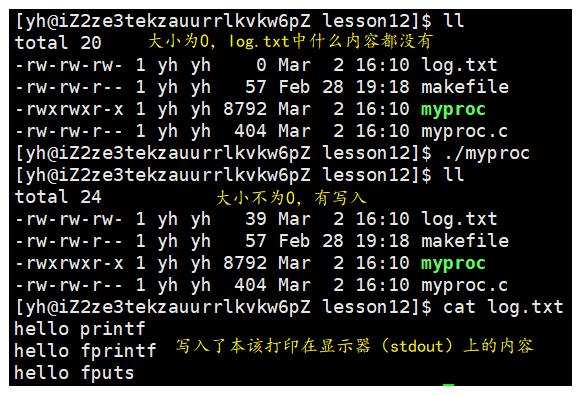
代码一开始关闭了文件描述符为1的文件,即关闭了显示器,切断了1和stdout之间的联系。而printf以及fprintf和puts都向stdout这一FILE*的指针输入,在系统调用时只看1,而不管1是与stdout对应还是与其他文件对应,在上面的代码中,1与log.txt对应,所以所有向屏幕的输出都输入到了log.txt,也即重定向到了log.txt。
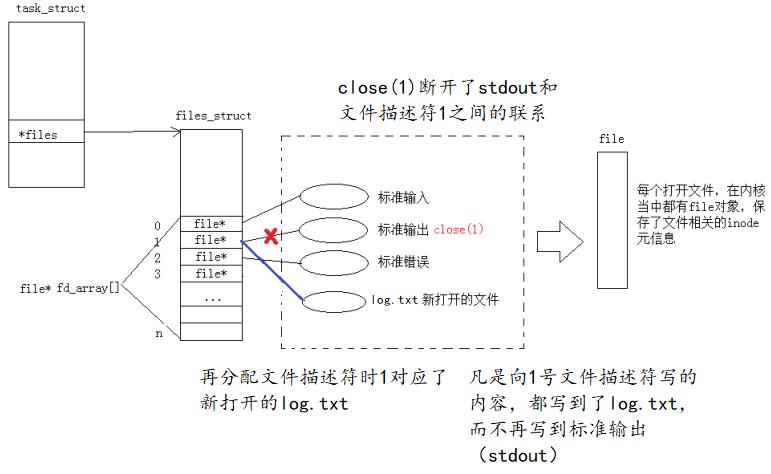
这里在各种打印结束后需要刷新stdout,因为向文件重定向时变成了全缓冲(下面会提到),如果不刷新就必须到缓冲区写满才会刷新,所以需要刷新stdout。
2.再谈缓冲区
在【Linux小练习】进度条程序 中简单介绍了缓冲区,这里再深入地讲一下缓冲区。
(1)缓冲方式
- 无缓冲
- 全缓冲:多用于(磁盘)文件写入时。
- 行缓冲:常见于对显示器进行刷新时。
缓冲就像送快递一样,无缓冲是拿到一个快递就送一个快递,全缓冲是拿到所有快递后一次送完,行缓冲是拿到一定数量的快递就送一批。显然全缓冲从送快递的人的角度来看效率最高。
要刷新的数据就像快递,送快递就是将内容从缓冲区写到文件中。由于磁盘文件、显示器等都是外设,写入的效率很低,所以采用全缓冲来提高一些效率。但向显示器刷新时,显然我们都希望尽快从显示器得到结果,但不缓冲的效率太低了、行缓冲打印内容又不及时,所以折中采用行缓冲的方式。
(2)缓冲区
#include <stdio.h>
#include <sys/types.h>
#include <sys/stat.h>
#include <unistd.h>
#include <fcntl.h>
#include <string.h>
int main()
//C
printf("hello printf\\n");
fprintf(stdout, "hello fprintf\\n");
//system
const char* msg = "hello write\\n";
write(1, msg, strlen(msg));
fork();//在最后创建子进程
return 0;

由上面的结果可得:
- 重定向与否会更改缓冲方式(向显示器打印是行缓冲,但向磁盘文件写入是全缓冲)。
- C语言的函数接口打印了两次,而系统接口只打印了一次。
上面现象的解释如下:
- 向显示器打印时,按行刷新,所以fork时缓冲区里的内容都已经打印完了(打印且刷新到显示器),创建子进程不会有影响。
- 但向磁盘文件(log.txt)重定向时,缓冲方式是全缓冲,当代码走到fork时,仅仅打印,但还没有刷新,当父子进程有一个刷新时,发生了写时拷贝,所以C语言接口打印的内容有两份。而write系统调用是没有缓冲区的,所以只会打印一次。
由此可知,所谓的缓冲区其实是语言自带的(C语言中的缓冲区在FILE结构体中维护),而系统并没有缓冲区。
下面是C语言FILE结构体中与缓冲区相关的内容
//缓冲区相关
/* Note: Tk uses the _IO_read_ptr and _IO_read_end fields directly. */
char* _IO_read_ptr; /* Current read pointer */
char* _IO_read_end; /* End of get area. */
char* _IO_read_base; /* Start of putback+get area. */
char* _IO_write_base; /* Start of put area. */
char* _IO_write_ptr; /* Current put pointer. */
char* _IO_write_end; /* End of put area. */
char* _IO_buf_base; /* Start of reserve area. */
char* _IO_buf_end; /* End of reserve area. */
/* The following fields are used to support backing up and undo. */
char *_IO_save_base; /* Pointer to start of non-current get area. */
char *_IO_backup_base; /* Pointer to first valid character of backup area */
char *_IO_save_end; /* Pointer to end of non-current get area. */
3.输入重定向
输入重定向道理与输出重定向相同,就是关闭文件描述符0,然后通过分配规则将0赋给一个文件,从stdin中读入时就变成了从该文件中读。
#include <stdio.h>
#include <sys/types.h>
#include <sys/stat.h>
#include <unistd.h>
#include <fcntl.h>以上是关于万字详解Linux系列基础IO的主要内容,如果未能解决你的问题,请参考以下文章